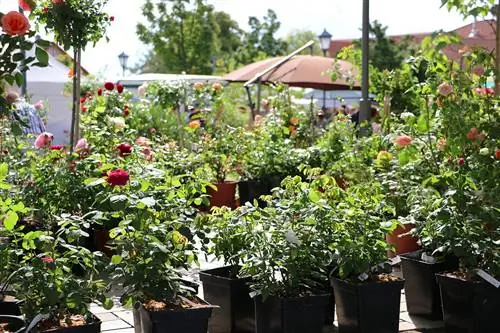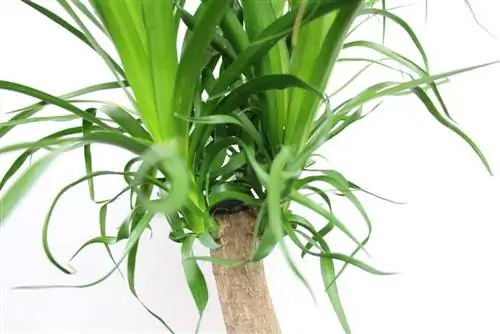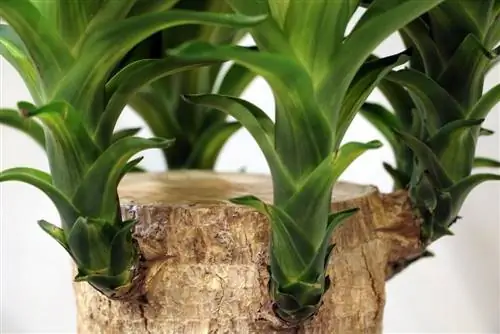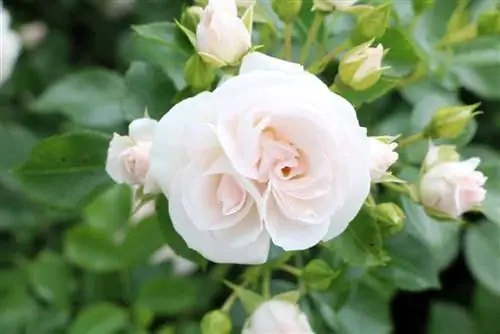- Author admin [email protected].
- Public 2023-12-17 03:39.
- Last modified 2025-01-24 12:45.
Rose cuttings are ideal for growing new plants. However, there are some important factors to consider. With the following tips, rooting and sprouting are guaranteed to be successful.
Important requirements
When propagating roses, the fastest way is to plant cuttings. This method is easy to implement and does not require much work. Even withered shoots from a bouquet of flowers are suitable for propagation if they are not highly bred specimens. Although some rose varieties can also be propagated using seeds, this generative propagation method usually results in a mixed variety with new attributes. The reason for this is pollination, as the different varieties cross each other. If you want to get exactly the same rose variety with the same flower color again, only vegetative propagation is suitable.
- Propagation from cuttings ideal for ground cover, wild and dwarf roses
- Rose varieties must be robust and rootless
- The optimal time is the end of June to the beginning of August
- Young shoots should already be slightly woody
- They are then ready for planting
- Shoots that are too green and flexible are rather unsuitable
Note:
Breded bed and noble roses cannot be grown in this way because they lack the necessary growth and root strength.
Preparing the bed
So that the cuttings can grow well, the garden bed must be prepared accordingly beforehand. In addition, when propagating outdoors, the location must be chosen carefully. Although adult roses like sunny conditions, the young cuttings are still very sensitive in this regard. To make planting easier, you can use a shovel to make the necessary holes in the soil. To promote growth, it is a good idea to fill some rooting powder into the planting holes.
- Partly shaded to shady location is ideal
- Make sure the location is sheltered from the wind
- It is essential to avoid direct midday heat
- Soil rich in humus and slightly sandy is optimal
- In very clayey soils, incorporate some sand
- Thoroughly loosen and clean the soil
- Plant substrate must not be too moist
Prepare cuttings
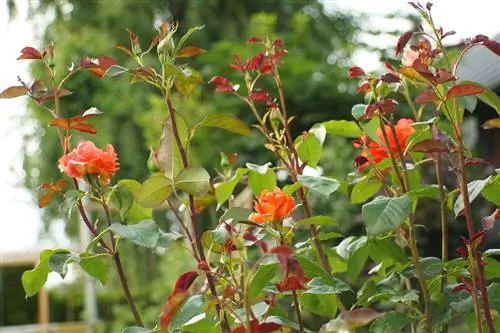
Selecting and preparing suitable shoots is crucial when taking rose cuttings. This increases the chance that the cuttings will take root quickly and thrive. The rose shoots should be completely fresh and there should be no dry areas visible. But weak and stunted shoots are also not suitable for propagation. It is important to have a strong and he althy mother plant that does not show any deficiency symptoms. The selected shoots should still be relatively young, as they usually have more growth energy. To increase the success rate of cultivation, approximately three cuttings per variety are required. After choosing the right rose shoots, appropriate preparation is necessary before planting.
- Shoots as thick as a pencil that have just bloomed are ideal
- Cut off dead flowers and thorns
- Short to a length of about 15 to 20 cm
- Cuttings should have at least five eyes
- Make the cut at an angle on the underside
- Makes it easier to absorb water and nutrients later
- Remove all leaves from the shoots to reduce evaporation
- The top pair of leaves can remain standing
- Then place cuttings in soil and water thoroughly
Tip:
When cutting cuttings, be sure to use sharp and disinfected tools to avoid diseases caused by contamination.
Watering with willow water
The rooting of rose cuttings can also be accelerated by adding fertilizer. However, chemical products are harmful to the environment and are therefore not suitable for a natural garden. On the other hand, prudent gardeners rely on natural resources such as willow water to help the flowers grow. This product can be made quickly and easily on your own to moisten the substrate during cultivation and provide it with lots of nutrients. The willow branches contain phytohormones, the so-called auxins, which sustainably promote the growth of flowers.
- Young and fresh willow branches are ideal
- Grow near rivers and other bodies of water
- Roughly cut into small pieces
- Fill in a sturdy and heat-resistant container
- Then pour boiling water over it
- Close with a well-fitting lid
- Then let it steep for at least 24 hours
- Then pour willow water through a sieve
- Water rose cuttings daily with it
Potato as a root aid
Rose cuttings root significantly better if they receive rooting support, for example in the shape of a potato. Thanks to this natural starting aid, the shoot receives many vital nutrients for growth. The tuber also provides a little moisture even on dry days. The procedure is very simple and has a resounding effect.
- Prick or drill a hole in the potato
- Circumference corresponds approximately to the thickness of the shoot
- Insert the rose cutting with the stem end
- Potato with rose shoot buried in soil
- At a depth of about 5 to 10 cm
- Water vigorously and never let it dry out completely
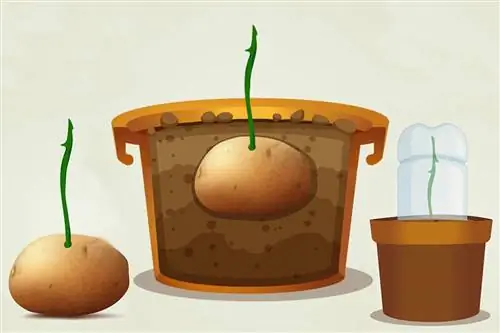
Plastic bottle as a greenhouse
Roses like warm temperatures and therefore grow well, especially in warm summers. However, in these latitudes it can be cool and constantly cloudy even in the summer months. Then the chances of successful reproduction decrease. The solution to this problem is to use a plastic bottle. In this way, a moist and warm microclimate can be created, which significantly promotes cultivation and rooting. However, regular oxygen exchange is necessary to prevent fungi or other diseases from establishing themselves.
- Use clear plastic bottle
- The ideal volume is at least 1.5 liters
- Cut off the bottom of the plastic bottle
- Put a bottle over each cutting
- Remove the cap every 2 to 3 days
- Water cuttings sufficiently, but not excessively
- Leave the shutter open for a few hours to ventilate
- As soon as you see shoots, remove the plastic bottle
- Alternatively, you can also use a disposable glass
Propagation in pots
As an alternative to growing outdoors, rose shoots can also be propagated in pots. This means that there are no restrictive limits when it comes to the time of cultivation; in fact, the procedure is possible until the end of the flowering period. In addition, not every hobby gardener has a garden available; in some cases it is only possible to grow in pots on the balcony or terrace. However, specimens grown in pots must be given warm winter protection before the first frosty nights. Otherwise, moving to a frost-free and bright winter quarters is also conceivable. The following spring, the young plants can then move into the garden bed and spend the next winter outside without any problems.
- Choose a sufficiently large pot
- Vessel with a depth of at least 30 to 40 cm
- Alternatively, a propagation box is possible
- Pile some pottery shards at the bottom of the vessel
- Shards prevent the plant substrate from rinsing out
- Then fill with potting soil
- Lightly sandy potting or garden soil is ideal
- Otherwise mix normal substrate with a little sand
Wait with patience
Even if the rose cuttings are under a protective and warming hood, it may take longer for them to sprout. The exact duration depends on the respective rose variety and the weather conditions. A few weeks or months can pass until the first roots form and new leaves appear. That's why a lot of patience is required, and the care of the roses must always remain consistently good.
- To check the rooting, never pull the cutting
- The first and delicate fibrous roots could be injured in this way
- Brown or black discolored cuttings no longer root
- These start to rot and belong in the compost
- Sprouting of the first leaves is an indication of successful propagation

